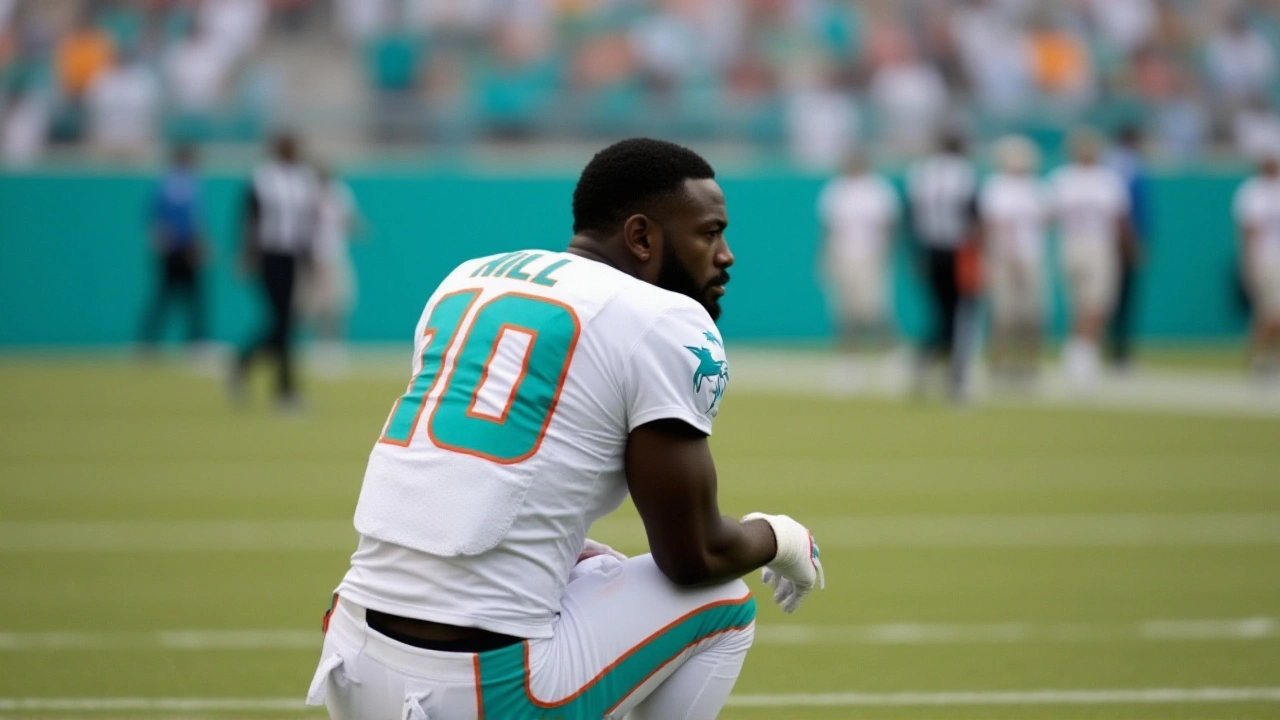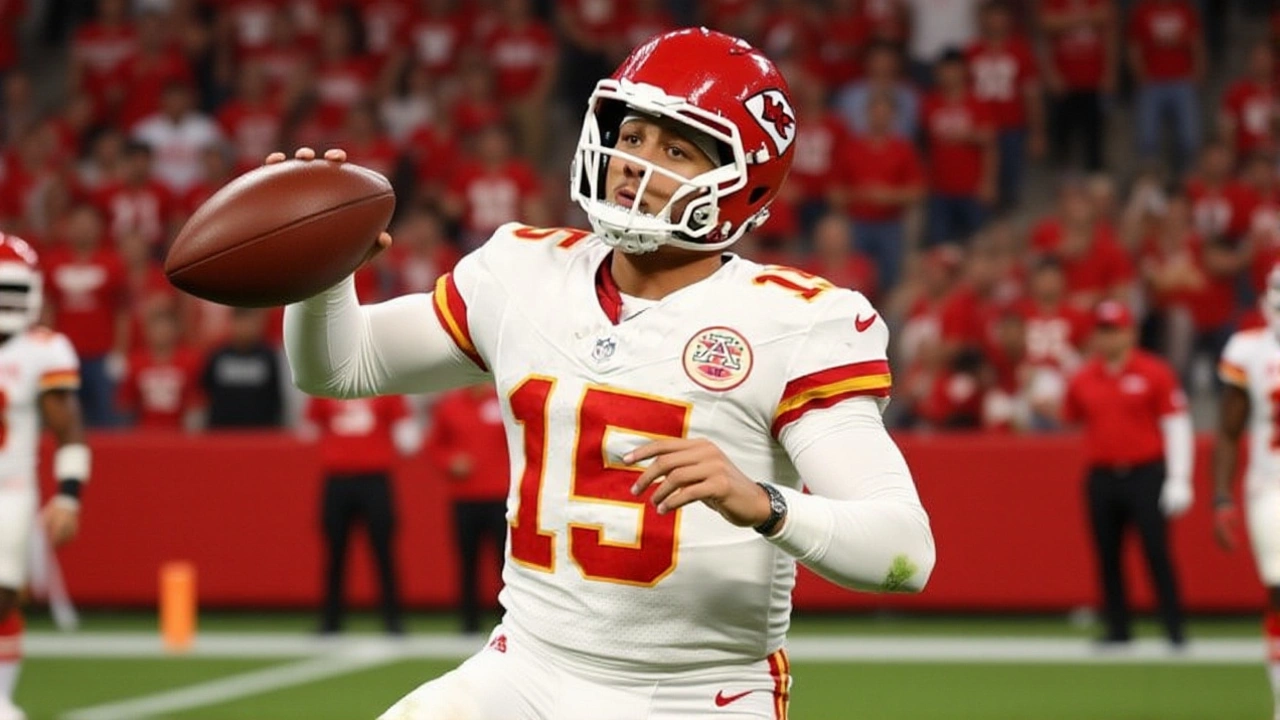
When Tyreek Hill, wide receiver of the Miami Dolphins, suffered a dislocated left knee on Monday night, the entire league felt the tremor.
The incident unfolded during the Week 4 matchup against the New York JetsHard Rock Stadium, Miami Gardens, Florida. Hill was sprinting down the sideline for a third‑down catch when his leg twisted unnaturally, forcing the medical crew onto the field within seconds.
The Injury and Immediate Aftermath
ESPN’s replay showed Hill’s thigh bending at an angle no human joint is meant to achieve – a visual that sent shivers through coaches and fans alike. He was carted off, receiving wishes from both teams, and rushed to a local hospital for evaluation. Early reports from the team’s medical staff point to a severe ligament tear accompanying the dislocation, effectively ending his 2025 season.
Coach Mike McDaniel addressed the locker room shortly after, his tone a mix of disappointment and resolve: “We’ve lost a huge piece of the puzzle, but we’ve got guys who will step up.” The Dolphins later sealed the 27‑21 win with a touchdown pass to tight end Darren Waller, who celebrated his first game back since 2023.
How Hill Shaped Miami's Offense
Since arriving in 2022, Hill has been the centerpiece of an offense built on speed, motion, and split‑second decision‑making. Quarterback Tua Tagovailoa often uses Hill as a deep‑stretch option, forcing defenses to respect his ability to break away at 23‑mph. The resulting scheme, a hybrid of West Coast precision and Air Raid explosiveness, has seen Hill targeted on 30+% of passing plays each season.
What made Hill uniquely dangerous wasn’t just his raw speed; it was his jitter‑stop‑start rhythm that left coverage units guessing. Defenders would commit to his blistering burst, only to see him slam on the brakes and cut inside, turning a routine route into a big‑play opportunity.
Deep‑Bench Options and Tactical Shifts
With Hill out, the Dolphins’ depth chart suddenly looks thin at the elite receiver slot. Jaylen Waddle, the other speedster, will see an elevated role, but even his 6‑4‑5 profile lacks Hill’s stop‑and‑go deception.
Running back De'Von Achane, who earlier said “next man up,” is likely to be used more as a receiver out of the backfield. The team has also started rotating Mike Washington in versatile snap‑count packages, and the offensive line has experimented with two‑tight‑end formations on 14% of plays – a stark jump from zero usage in the first three weeks.
These adjustments are not merely stop‑gaps; they represent a philosophical shift. Without Hill forcing double‑coverage, the Dolphins can spread the field more evenly, potentially exploiting mismatches against slower linebackers.

Implications for Playoff Hopes and Contract Talk
At 28, Hill sits on a five‑year, $135 million extension signed in 2023. The knee dislocation raises immediate questions about his long‑term health and the franchise’s salary‑cap flexibility. If Hill’s recovery drags into 2026, Miami may need to consider restructuring his deal or finding a cost‑effective replacement in free agency.
From a competitive standpoint, the Dolphins sit at 1‑3 after a hard‑won victory over a winless Jets squad. Losing their premier weapon turns what was already an uphill climb into a steep decline. The AFC East rivals – the Bills, Patriots, and Browns – will likely exploit Miami’s weakened passing attack, especially in the upcoming divisional stretch.
Looking Ahead: Recovery Timeline and Next Steps
Orthopedic specialists estimate a minimum of 9‑12 months for a dislocated knee with ligament damage, meaning Hill will miss the bulk of the 2025 campaign and possibly the early portion of 2026. Rehabilitation will focus on regaining range of motion, strengthening the quadriceps and hamstrings, and eventually rebuilding the explosive burst that defined his play.
In the meantime, the Dolphins’ front office, led by General Manager Chris Grier, faces a deadline to sign or promote a reliable slot receiver before the next trade deadline. The team’s scouting department has already identified several free‑agent candidates with the necessary route‑running precision to fill the void, albeit without Hill’s game‑changing speed.
For fans, the loss is more than a statistical setback; it’s the removal of a player who turned routine catches into viral moments. Yet the crisis also presents an unexpected chance for younger players – from the practice squad wideouts to the tight‑end rotation – to claim their own spotlight.
Frequently Asked Questions
How long is Tyreek Hill expected to be out?
Medical staff project a 9‑to‑12‑month recovery for a dislocated knee with ligament involvement, meaning Hill will miss the rest of the 2025 season and could return early in 2026.
What immediate changes will the Dolphins make on offense?
Coach McDaniel is expected to increase two‑tight‑end sets, give Jaylen Waddle a larger share of deep routes, and use De'Von Achane more as a pass‑catching back while rotating versatile play‑makers like Mike Washington.
Will Hill's contract be affected by the injury?
While the contract itself is guaranteed, the Dolphins may look to renegotiate salary cap allocations if Hill's recovery extends into 2026, potentially freeing up space for a replacement or additional depth.
How does this injury impact Miami's playoff chances?
Losing Hill drops the Dolphins' offensive efficiency dramatically. To stay competitive in the AFC East, Miami must rely on a more balanced attack and hope the defense can keep games close.
Who are potential free‑agents the Dolphins could sign?
Analysts point to veterans like Marquez Callaway and emerging talent such as Kadarius Toney as possible low‑cost additions who can provide reliable route running without the speed ceiling Hill offered.
